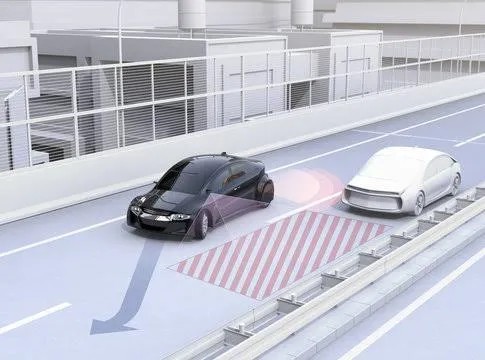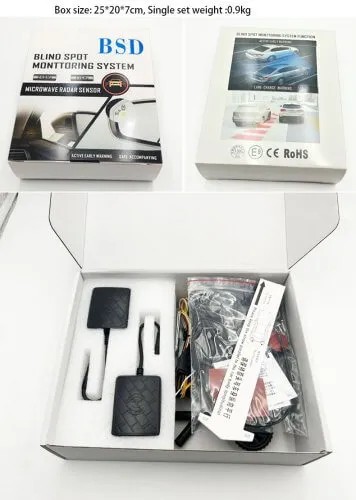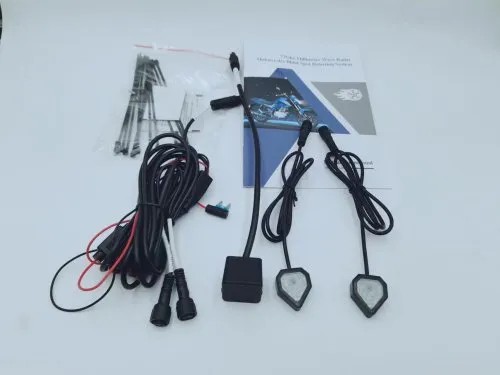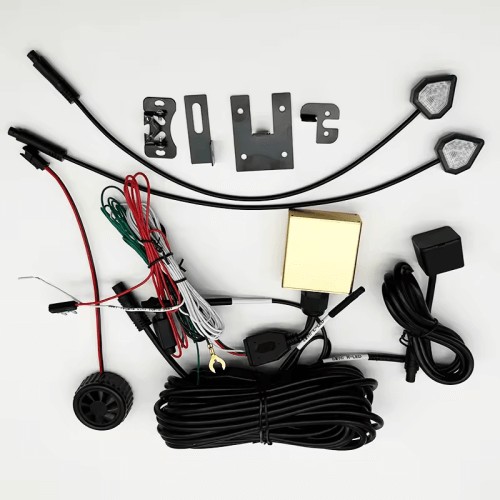Introduction
Driving safely is paramount, and in today’s busy roads, it’s more challenging than ever. One of the inherent limitations drivers face is blind spots. These are areas around your vehicle that are obscured from your direct line of sight and even your mirrors. Vehicles, by their very design with pillars and bodywork, create these zones of invisibility. If your car didn’t come equipped with a blind spot monitoring system from the factory, these blind spots can pose a significant safety risk, especially during lane changes or merging.
Fortunately, the automotive aftermarket offers a solution: Aftermarket Blind Spot Monitoring systems. While many newer vehicles integrate blind spot detection as a standard feature, a robust market exists for upgrading older cars or those base models lacking this crucial technology. The variety of aftermarket blind spot monitoring systems available is extensive, ensuring that most car owners can find a compatible system. However, before investing, it’s essential to understand what these systems are, how they function, and whether they are a worthwhile addition to your vehicle.
Understanding Aftermarket Blind Spot Monitoring Systems
An aftermarket blind spot monitoring system is essentially a network of electronic components designed to actively scan and monitor the areas around your vehicle that you can’t easily see. These systems are designed to detect vehicles or other moving objects that enter your blind spots and alert you to their presence. The fundamental purpose of these systems is to provide an extra layer of safety, warning drivers of potential hazards they might otherwise miss, thereby helping to prevent accidents.
Whether it’s a simple system monitoring a single blind spot or a more sophisticated setup covering multiple zones, the core function remains the same: to detect and warn. This warning is crucial, giving drivers the information they need to make safer decisions on the road.
Key Components of an Aftermarket Blind Spot Monitor Kit
While the specific components can vary slightly depending on the manufacturer and system complexity, a typical blind spot monitor kit for aftermarket installation generally includes these essential parts:
- Millimeter Wave Radar Sensors (or sometimes Ultrasonic Sensors): These are the eyes of the system. Typically mounted on the rear bumper or sides of the vehicle, these sensors emit radar waves (or ultrasonic waves) to detect objects in the blind spot zones. Radar sensors are generally preferred for their longer range and better performance in various weather conditions.
- Indicator Lights (LEDs): These visual alerts are usually mounted on the A-pillars or side mirrors, within the driver’s peripheral vision. They illuminate to warn of a detected vehicle in the blind spot.
- Audible Buzzer or Alarm: An auditory warning that sounds in conjunction with the indicator lights to further alert the driver, especially when a turn signal is activated.
- Control Module (ECU): The brain of the system. This electronic control unit processes the signals from the sensors, determines if a threat exists, and activates the indicator lights and buzzer.
- Wiring Harnesses: These are essential for connecting all the components to the vehicle’s electrical system, providing power and communication pathways. Wire harnesses ensure a clean and reliable installation.
- Mounting Brackets and Hardware: Necessary brackets for securely mounting the radar sensors and indicator lights to the vehicle.
- Double-Sided Adhesive Stickers: Used for easy mounting of indicator lights in some installations, though more robust mounting solutions are often preferred for long-term reliability.
More advanced aftermarket blind spot monitoring systems might also include features like adjustable sensitivity, customizable warning sounds, or integration with in-car displays. However, the basic components listed above form the foundation of most systems, providing reliable blind spot detection capabilities.
Alt Text: Aftermarket blind spot monitoring system components laid out, showcasing radar sensors, indicator lights, buzzer, and wiring harnesses.
How Aftermarket Blind Spot Monitoring Systems Work: The Science of Safety
The working principle behind most aftermarket blind spot monitoring systems revolves around radar technology, specifically millimeter wave radar. Here’s a breakdown of the process:
1. Active Detection with Radar:
The core of the system is the radar sensor. These sensors continuously emit millimeter waves – a type of electromagnetic wave – into the designated blind spot zones beside and sometimes behind the vehicle. These waves are invisible and harmless.
The frequency of these radar waves can vary, with common frequencies including 24 GHz, 58 GHz, and the more advanced 77GHz to 79GHz bands. Higher frequency radar often offers better precision and detection capabilities.
2. Signal Reflection and Object Detection:
When these radar waves encounter an object, such as another vehicle, they are reflected back to the sensor. The system’s sophisticated software analyzes these reflected waves. By measuring the time it takes for the waves to return and the changes in their frequency (Doppler effect), the system can determine:
- Presence of an Object: The system detects if something is within the blind spot zone.
- Distance: It calculates how far away the object is.
- Speed (in some systems): More advanced systems can even determine the speed and direction of the approaching object relative to your vehicle.
3. Intelligent Alert System:
Once the system detects a vehicle or object within the blind spot and determines it could be a potential hazard (based on proximity and speed), it triggers the warning system. This typically involves two types of alerts:
- Visual Warning: Indicator lights, usually LEDs placed in the side mirrors or A-pillars, illuminate. These lights are positioned to be easily seen in the driver’s peripheral vision without being distracting.
- Audible Warning: A buzzer or chime sounds to draw the driver’s attention. Many systems are designed to activate the audible warning specifically when the turn signal is engaged in the direction of the detected object, indicating an intended lane change into a potentially unsafe zone. This prevents nuisance alarms and focuses the audible warning on critical moments.
4. Driver Action and Enhanced Safety:
The purpose of these warnings is to provide the driver with timely information, allowing them to make informed decisions. For example, if the indicator light illuminates and the buzzer sounds when the driver signals to change lanes, it warns them not to proceed with the lane change until the blind spot is clear. This significantly reduces the risk of side-swipe collisions.
This rapid and reliable detection and warning process is what makes aftermarket blind spot monitoring systems such a valuable safety enhancement.
Key Features and Benefits of Aftermarket Blind Spot Monitoring Systems
Aftermarket blind spot detection systems offer a range of features, enhancing driving safety and convenience. The specific features can vary between systems, but some of the most valuable include:
Lane Change Assist (LCA)
Lane Change Assist, or LCA, is a primary function of most blind spot monitoring systems. It’s designed to make highway driving and lane changes safer. Side mirrors alone often fail to provide a complete view of adjacent lanes, especially at highway speeds where vehicles can approach quickly. LCA actively monitors these adjacent lanes.
How LCA Enhances Safety:
- Reduces Lane Change Accidents: By alerting you to vehicles in your blind spot when you signal a lane change, LCA significantly decreases the risk of side-swipe accidents, a common type of collision on multi-lane roads.
- Especially Useful for Larger Vehicles: Trucks, SUVs, and vans have larger blind spots, making LCA even more critical for these vehicle types.
- Reduces Driver Stress: Knowing you have an extra set of “eyes” monitoring your blind spots can reduce driver fatigue and stress, particularly on long journeys.
- Speed Activation: Often, LCA systems are programmed to activate only above a certain speed threshold, like 15-20 mph, as blind spots are less of a concern at very low speeds.
Rear Cross-Traffic Alert (RCTA) – Expanding Blind Spot Protection
Alt Text: Rear view of a car backing out of a parking space, illustrating the scenario where Rear Cross-Traffic Alert is most beneficial.
While “blind spot” often refers to the side blind spots, the area behind your vehicle when reversing is also a critical blind zone. Rear Cross-Traffic Alert (RCTA) addresses this.
How RCTA Works and Benefits:
- Reversing Safety: RCTA is invaluable when backing out of parking spaces, driveways, or any situation where your rear view is obstructed.
- Detects Approaching Vehicles: The system uses rear-mounted sensors to detect vehicles approaching from the sides that may be out of your line of sight.
- Early Warning of Rear Hazards: If a vehicle is approaching from the side while you are reversing, RCTA will provide a visual and audible warning, giving you time to stop and avoid a collision.
- Always Active: Unlike LCA, RCTA typically activates as soon as the vehicle is started and put into reverse, providing continuous protection when maneuvering at low speeds.
Early Warning Systems for Enhanced Reaction Time
Alt Text: Diagram illustrating the extended detection range of an aftermarket blind spot monitor’s early warning system, showing detection zones beyond standard mirrors.
Some advanced aftermarket blind spot systems incorporate an early warning strategy. This feature is designed to provide alerts even sooner, giving drivers more time to react.
How Early Warning Enhances Safety:
- Increased Detection Range: Early warning systems often have a wider detection range, spotting vehicles approaching from further away in the blind spot.
- Two-Stage Warning: Some systems employ a two-stage warning approach. A less urgent initial warning (e.g., just the indicator light) might activate when a vehicle is detected at a greater distance. If the approaching vehicle gets closer or the driver signals a lane change, a more urgent warning (light and buzzer) is triggered.
- More Time to React: The earlier the warning, the more time a driver has to assess the situation, check their mirrors, and make a safe driving decision, further minimizing the risk of accidents.
Are Aftermarket Blind Spot Monitors a Necessity for Every Driver?
The question of necessity is important. If your vehicle already has a factory-installed blind spot monitoring system that functions reliably, adding an aftermarket system might be redundant. However, for a significant portion of drivers, especially those with older vehicles or base models, aftermarket blind spot monitoring systems transition from a “nice-to-have” to a “need-to-have” safety feature.
Why Aftermarket Blind Spot Monitoring Systems Are Increasingly Essential:
- Addressing Inherent Vehicle Limitations: No matter how skilled a driver is, human vision has limitations, and vehicle design creates blind spots that are simply impossible to eliminate through mirrors alone.
- Increased Road Congestion: Roads are becoming more crowded, and traffic moves faster in many areas. This increases the frequency of lane changes and merging, making blind spot monitoring more crucial.
- Distracted Driving: While not an excuse, distracted driving is a reality. Blind spot monitors provide an extra layer of safety to compensate for momentary lapses in attention.
- Aging Vehicle Fleet: Many vehicles on the road lack modern safety technologies. Aftermarket systems offer a way to bring older cars up to modern safety standards.
- Relatively Low Cost, High Benefit: Compared to the potential cost of an accident (vehicle damage, injuries, insurance costs), aftermarket blind spot systems are a relatively affordable safety upgrade.
In essence, if your vehicle is not equipped with a reliable blind spot monitoring system, investing in a quality aftermarket system is a proactive step towards enhancing your safety and the safety of others on the road.
Key Factors to Evaluate When Choosing an Aftermarket Blind Spot Monitor
If you’ve decided to upgrade your vehicle with an aftermarket blind spot monitoring system, it’s important to choose wisely. Not all systems are created equal. Here are critical factors to consider to ensure you select a system that provides genuine value and safety:
1. Detection Range: Seeing Farther for Greater Safety
Detection range is arguably the most critical specification. A system with a limited detection range might only warn you when a vehicle is already very close, reducing your reaction time.
What to Look For:
- Adequate Range: Aim for a system with a detection range of at least 35-50 meters (approximately 115-165 feet) to the rear and 10-15 meters (approximately 33-50 feet) to the sides. This provides ample warning distance.
- Radar Frequency and Quality: Higher frequency radar (77-79GHz) generally offers better range and accuracy. The quality of the radar sensor itself is also crucial for reliable performance.
- Obstruction Considerations: Be aware that metallic bumpers or obstructions can reduce radar performance. Most systems are designed for plastic bumpers.
Alt Text: Diagram illustrating the detection range of a blind spot monitoring system, highlighting the area covered behind and to the sides of the vehicle.
2. Detection Accuracy: Minimizing False Alarms
While a good detection range is vital, accuracy is equally important. A system that frequently triggers false alarms (warning you when there’s no actual threat) can become annoying and lead you to ignore warnings, defeating the purpose of the system.
What to Look For:
- High Accuracy Rate: Look for systems with a stated high accuracy rate and low false alarm rate.
- Sensor Calibration: Some higher-end systems offer calibration features to fine-tune sensor sensitivity and minimize false alarms in specific environments.
- Quality Components: Reputable brands and systems using quality sensors are generally more accurate.
- Detection Thresholds: Intelligent systems use algorithms to differentiate between genuine threats (vehicles) and less relevant objects, reducing false alarms.
3. Additional Features: Enhancing Value and Functionality
Beyond the basic blind spot detection, consider systems that offer extra features that enhance their value and usability:
- Speed and Distance Measurement: Systems that can measure the speed and distance of approaching vehicles can provide more nuanced warnings and potentially trigger earlier alerts for faster-approaching vehicles.
- Adjustable Sensitivity: The ability to adjust the system’s sensitivity can be useful to customize it to your driving style and environment.
- Customizable Alerts: Some systems allow you to adjust the volume of the buzzer or the brightness of the indicator lights.
- Integration with Vehicle Systems: While less common in basic aftermarket systems, some advanced systems might offer integration with your car’s display screen or CAN bus system for more sophisticated features.
Will Evolving Car Technology Eliminate the Need for Aftermarket Blind Spot Systems?
While modern vehicles increasingly come with factory-installed blind spot monitoring, the need for aftermarket solutions is unlikely to disappear soon.
Why Aftermarket Systems Will Remain Relevant:
- Existing Vehicle Fleet: Millions of cars on the road are older models without factory blind spot systems. The aftermarket provides the only practical way to equip these vehicles with this technology.
- Cost Considerations: Even on newer cars, blind spot monitoring is often an optional extra, not standard on base models. Aftermarket systems offer a more affordable way to add this feature.
- System Failures and Repairs: Factory systems can fail or be damaged. Repairing OEM systems can be very expensive. Aftermarket systems often offer a more cost-effective replacement option.
- Customization and Upgrades: The aftermarket allows for innovation and customization. Aftermarket companies can introduce new features and technologies faster than OEM integration cycles.
- DIY Installation: Many aftermarket systems are designed for relatively easy DIY installation, making them accessible to a wider range of car owners.
OEM vs. Aftermarket Blind Spot Monitoring Systems: Weighing the Options
When considering blind spot monitoring, you essentially have two main paths: OEM (Original Equipment Manufacturer) systems and aftermarket systems.
OEM Blind Spot Monitoring Systems: Factory Integrated Safety
Pros of OEM Systems:
- Factory Integration: Designed and integrated into the vehicle from the factory, often resulting in seamless operation and aesthetics.
- Reliability (Generally): OEM systems are typically rigorously tested and designed to meet vehicle manufacturer standards.
- Potential for Advanced Features: OEM systems may be integrated with other vehicle safety systems and offer more advanced features.
Cons of OEM Systems:
- Higher Cost: OEM systems are typically more expensive, often bundled into higher trim levels or option packages.
- Repair Costs: As mentioned, OEM system repairs can be significantly more costly and complex.
- Limited Availability: Only available on vehicles that are factory-equipped with the system. Retrofitting OEM systems to older cars is usually impractical and expensive.
Aftermarket Blind Spot Monitoring Systems: Accessible and Affordable Upgrades
 aftermarket blind spot monitoring systems 5
aftermarket blind spot monitoring systems 5
Alt Text: Close-up of aftermarket blind spot monitor indicator light integrated into a car’s side mirror, showcasing discreet installation.
Pros of Aftermarket Systems:
- Lower Cost: Significantly more affordable than OEM systems, making blind spot monitoring accessible to more car owners.
- Retrofit Capability: Designed to be installed on a wide range of vehicles, especially older models that lack factory systems.
- Ease of Installation (in many cases): Many systems are designed for relatively straightforward DIY installation.
- Repair and Replacement Affordability: Repairs or replacements are generally less expensive than OEM systems.
- Variety and Choice: A wide range of aftermarket systems are available, offering different features and price points to suit various needs and budgets.
Cons of Aftermarket Systems:
- Installation Effort: While many are DIY-friendly, installation still requires some technical skill and time.
- Potential for Lower Integration Aesthetics: Aftermarket systems may not always look as seamlessly integrated as factory systems, although many modern systems are designed for discreet installation.
- Varying Quality: Quality can vary between brands and systems. It’s crucial to choose reputable brands and read reviews.
Understanding the Cost of Aftermarket Blind Spot Monitoring Systems
The cost of aftermarket blind spot monitoring systems is a key factor for many buyers. Fortunately, these systems are generally quite affordable, especially compared to the safety benefits they offer and the cost of OEM systems.
Typical Cost Ranges:
- Basic Car Systems: For standard cars and sedans, a good quality aftermarket blind spot monitoring system can range from approximately $300 to $750.
- Truck and Larger Vehicle Systems: Systems for trucks, SUVs, and larger vehicles, which may require more robust sensors or wider detection ranges, might range from $500 to $2500.
- Installation Costs: If you choose professional installation, factor in an additional $200 to $300 for labor, although many systems are designed for DIY installation, saving on this cost.
Factors Affecting Cost:
- Features: Systems with more advanced features like rear cross-traffic alert, adjustable sensitivity, or more sophisticated radar technology will generally cost more.
- Brand Reputation: Established and reputable brands may command a slightly higher price but often offer better quality and reliability.
- Sensor Type and Quality: Systems using higher-quality radar sensors or more advanced ultrasonic sensors may be more expensive.
- Vehicle Type: Systems designed for larger vehicles or those requiring specialized installation might be pricier.
Value Proposition:
Despite the cost, consider the value proposition. Investing in an aftermarket blind spot monitoring system is an investment in safety. The cost is relatively small compared to the potential expenses and risks associated with accidents.
Conclusion: Making an Informed Decision About Aftermarket Blind Spot Monitors
Blind spot monitoring systems have become an increasingly vital safety technology in modern driving. They address a fundamental limitation of vehicle design and human vision, providing drivers with crucial information to prevent accidents, especially during lane changes and reversing.
While factory-installed systems are becoming more common, aftermarket blind spot monitoring systems offer a practical, affordable, and effective way to upgrade the safety of a wide range of vehicles, particularly older models or those lacking this feature.
By understanding how these systems work, their key features, and the factors to consider when choosing a system, you can make an informed decision about whether an aftermarket blind spot monitor is a worthwhile safety upgrade for your vehicle. For many drivers, the answer is a resounding yes.
OYI Electronic is a leading manufacturer specializing in aftermarket blind spot monitoring systems, serving customers globally with high-quality products. If you have further questions or need assistance in choosing the right system for your vehicle, please don’t hesitate to contact us!
Related Products:
 24G_V3 package
24G_V3 package
Alt Text: Universal 24G V3 aftermarket blind spot monitoring system package, highlighting product features and compatibility.
 77G motorcycle blind spot detection system
77G motorcycle blind spot detection system
Alt Text: 77G MT05-SET motorcycle blind spot detection system, showcasing compact sensors and indicator lights for motorcycle safety.
 77G truck blind spot detection system T5
77G truck blind spot detection system T5
Alt Text: 77G T5 truck blind spot detection system, designed for large vehicles with extended detection range and robust sensors.
